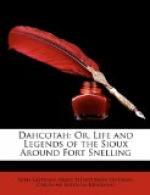The warriors then seize on the two boys and girls—the representations of war and peace—and use them as roughly as possible—taking their pipes and war-clubs from them, and rolling them in the dirt until the paint is entirely rubbed off from their faces. Much as they dislike this part of the dance, they submit to it through fear, believing that after this performance the power of thunder is destroyed.
Now that the water is drank up and the guardians of the Thunder bird are deprived of their war-clubs and pipes, a terrible wailing commences. No description could convey an idea of the noise made by their crying and lamentation. All join in, exerting to the utmost the strength of their lungs.
Before the men shoot at thunder, the squaws must leave the ring. No one sings at this dance but the warrior who gives it; and while the visitors, the dancers, and the medicine men, women and children, all are arrayed in their gayest clothing, the host must be dressed in his meanest.
In the dance Ahahkah Koyah, or to make the Elk a figure of thunder, is also made and fought against. The Sioux have a great deference for the majesty of thunder, and, consequently for their own skill in prevailing or seeming to prevail against it.
A Sioux is always alarmed after dreaming of an elk, and soon prevails upon some of his friends to assist him in dancing, to prevent any evil consequences resulting from his dream. Those willing to join in must lay aside all clothing, painting their bodies with a reddish gray color, like the elk’s. Each Indian must procure two long saplings, leaving the boughs upon them. These are to aid the Indians in running. The saplings must be about twelve feet in length. With them they tear down the bark image of thunder, which is hung with a string to the top of the pole.
All being ready, the elks run off at a gallop, assisted by their saplings, to within about two hundred yards of the pole, when they stop for a while, and then start again for the pole, to which is attached the figure of thunder.
They continue running round and round this pole, constantly striking the figure of thunder with their saplings, endeavoring to knock it down, which after a while they succeed in accomplishing.
The ceremony is now ended, and the dreamer has nothing to fear from elks until he dreams again.
There is no end to the superstitions and fancies entertained by the Sioux concerning thunder. On the cradle of the Indian child we frequently see the figure of thunder represented. It is generally carved on the wood by the father of the child, with representations of the Elk, accompanied with hieroglyphic looking figures, but thunder is regarded as the type of all animals that fly.




